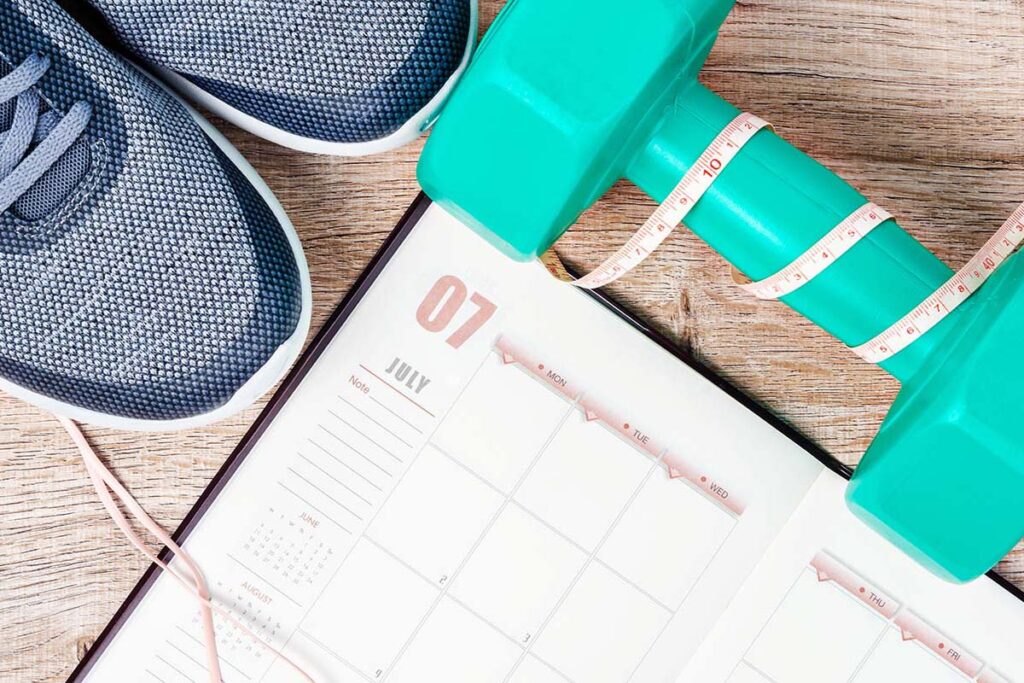Frequent exercise keeps the body fit and active, but physical activity can help with more than just physical health—it can also benefit your mind. According to research from Harvard Health, exercise can boost your memory, reduce stress and anxiety, and improve your overall mood and quality of sleep.
Mental Health and Fitness
When it comes to mental health, physical activity should not be overlooked. According to the Center for Disease and Control (CDC), effective exercise can help you think, learn, and problem solve; improve your memory; and reduce symptoms of anxiety and depression.
According to the Mayo Clinic, frequent exercise can help improve anxiety and depression for two main reasons:
- Exercise releases endorphins. Endorphins are a hormone produced in the brain that can relieve pain, improve your mood, lower stress, and enhance your overall feeling of well-being. Often referred to as the “feel good” chemical, endorphins produced while exercising may improve common symptoms of anxiety and depression.
- Exercise takes your mind off worries. Besides the chemical benefits, exercise can also simply help you take your mind off things that may be worrying you. Focusing your mind and body on running, weight lifting, or other physical activity can free your mind from overwhelming feelings of worry.

Besides dealing with symptoms of anxiety and depression, physical activity can help with other areas of mental health. Exercise can help you:
- Gain confidence. Meeting your fitness goals, losing or gaining weight, and becoming stronger can all contribute to your self-confidence, specifically regarding how you look and how you feel.
- Cope in a healthy manner. Rather than turning to substances like drugs or alcohol or dwelling on depressive and anxious feelings, exercise can be a healthy coping mechanism for unwanted emotions or worries.
Living an Active Lifestyle
According to the Mayo Clinic, most healthy adults should get 150 minutes of moderate aerobic activity each week, or at least 75 minutes of vigorous aerobic activity. Though, additional benefits may be had for those who perform 300 minutes of moderate aerobic activity each week.
As a general rule, it’s recommended to perform 30 minutes of physical activity each day, with more exercise recommended if an individual is looking to lose weight or meet specific fitness goals.

Exercising doesn’t just mean running on the treadmill or lifting weights in a gym. In fact, there are many practical ways that you can develop an active lifestyle. While running, walking, and swimming are popular aerobic workouts, activities such as dancing, gardening, and vigorous housework can also be good for physical activity and mental health.
Besides aerobic activity, many adults can benefit from strength training. According to the CDC, American adults should try incorporating muscle-strengthening activities into their physical activity at least two times a week. Exercises should target all the major muscle groups, including legs, hips, back, abdomen, chest, shoulders, and arms.
As you begin your active lifestyle, take into consideration these tips and best practices to keep your workouts effective and safe:
- Start with a warm-up. A good warm-up routine can prevent injury and soreness, and they usually take anywhere from five to 10 minutes. Do a quick walk, jog, or squats to get your blood pumping and warm up your muscles.
- End with a cooldown. Cooling down also reduces soreness and risk of injury. For five to 10 minutes, go for a short walk, stretch, and perform gentle movements for an effective cooldown.
- Drink plenty of water. Make sure to drink plenty of water while exercising to prevent dehydration and help your body function properly. According to Michigan Medicine, during exercise, you should drink seven to 10 ounces of water for every 10 to 20 minutes of physical activity.
- Don’t forget to take breaks. If you feel dizzy, dehydrated, or otherwise unwell during physical activity, don’t forget to take a break. Sit down and take a breather before jumping back into your workout.
Tips for Self-motivation
Once you begin exercising, it’s important to maintain your physically active lifestyle. Giving up or losing motivation may cause you to lose the physical and mental health benefits that come from working out.
Staying motivated to reach your fitness goals isn’t always easy; however, with tips and tricks like the list below, you can be encouraged to maintain your active lifestyle.
- Fit exercise into your everyday life. The more convenient exercise is, the more likely you are to keep doing it. Try to work exercise into your daily routine. This can be by taking your dog on a long walk, taking the stairs instead of the elevator, exercising during TV commercial breaks, and more.
- Exercise with fun activities. The more engaging and fun exercise is, the more you will want to do it. Rather than just forcing yourself to go to the gym, find exercises that you like. You can go for a swim with your family, ride bikes around the neighborhood, or spend time in nature with a hike.

- Track your progress. Another easy way to stay motivated is to track your progress. Seeing how far you’ve come will encourage you to keep going. This can be tracking daily steps, weight loss, how far you can run, and more. Don’t forget to reward yourself when you accomplish one of your goals!
- Set SMART goals. While goals are important, unrealistic standards will leave you feeling burnt out and unmotivated. Instead, try setting goals that are specific, measurable, achievable, relevant, and time-bound (SMART). This will help you maintain and succeed in your fitness goals.
- Go easy on yourself. Missing one workout is not the end of the world, and it doesn’t make you a failure. When mistakes inevitably end up happening, give yourself grace and be willing to jump back into your active lifestyle.
No matter your age, fitness level, or size, it’s never too late to become active. Starting and maintaining a healthy fitness regimen will help you improve your physical and mental health and overall well-being.
